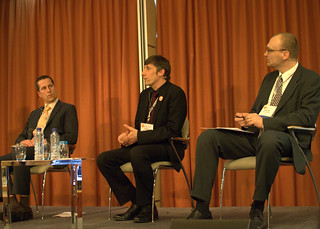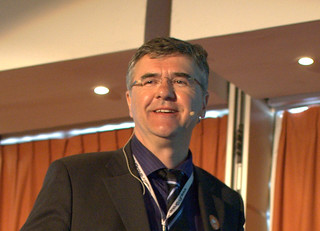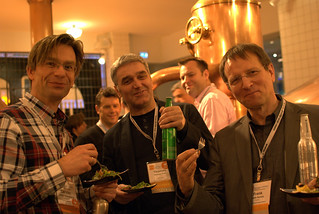I last left you hanging, waiting to hear more about the heated conversations between the panelists and the audience – and I have to tell you, it really started heating up in the audience during the energy panel. Oooh baby, it was jumping.
 MEMS in energy can mean a lot of things – and our panelists diverse perspectives discussed a great deal, but the majority of the audience wanted to focus on the topic of MEMS in energy harvesting. Though not necessarily experts in this field, thankfully our panelists were up to the challenge. Our moderator was Bert Gyselinckx, General Manager, Holst Centre, imec; Wim C. Sinke, Program Development Manager, Solar Energy, Energy Research Centre of the Netherlands; Eric Yeatman, Professor of Microengineering, Deputy Head of Department, Imperial College London; and Harry Zervos, Senior Technology Analyst, IDTechEx. I actually should probably add Rob Andosca of MicroGen Systems as a fifth panelist as he was eager to ask and answer any question from the audience with his BOLT energy harvester in hand.
MEMS in energy can mean a lot of things – and our panelists diverse perspectives discussed a great deal, but the majority of the audience wanted to focus on the topic of MEMS in energy harvesting. Though not necessarily experts in this field, thankfully our panelists were up to the challenge. Our moderator was Bert Gyselinckx, General Manager, Holst Centre, imec; Wim C. Sinke, Program Development Manager, Solar Energy, Energy Research Centre of the Netherlands; Eric Yeatman, Professor of Microengineering, Deputy Head of Department, Imperial College London; and Harry Zervos, Senior Technology Analyst, IDTechEx. I actually should probably add Rob Andosca of MicroGen Systems as a fifth panelist as he was eager to ask and answer any question from the audience with his BOLT energy harvester in hand.
I loved the diversity of perspective on this panel –Wim for example does not have an entirely MEMS-centric background. His expertise is in solar and photovoltaic energy and he spoke of how multiple technologies will work together to make reliable and sustainable energy system, as well as the importance of portfolio management – combining different energies in an active way to make it work. We in MEMS could learn a lot from guys like Wim (I hope everyone picked up his business card; I know I did).
The panel also spoke about wireless sensor networks and Harry gave a great overview of the three technologies that are converging: 1. Microgenerators and energy storage (vibration, solar, heat, tree resin, etc.); 2. Ultra low-power electronics (currently being developed) – helping power sensors; and 3. Transmission protocols that don’t need a lot of power to send data. Eric followed up with the poignant view that until things become truly wireless, you can’t really have wireless sensor networks. And once they are wireless how will they be powered – by energy harvesting or battery? This opened the floodgates and I, with microphone in hand had to jog all over the audience to capture the comments and follow-up questions from the audience.
Let me be diplomatic and say that there is no clear consensus out there on MEMS energy harvesting. And out came the very clever quotes including some of my favorites including this one from Wim: "Don’t look at MEMS as the energy harvesters, MEMS are the enablers to help realize energy savings." And this one from someone (maybe you’ll remember and leave a comment here): "I’m happy to hear everyone in MEMS talking about energy, but I can assure you that not everyone in energy is talking about MEMS...yet." And Bert’s: "MEMS will probably not be main source of energy replacing nuclear power plants soon; but MEMS will enable increased intelligence in energy applications." As great as these sound bytes were, the show stealer came when Rob Andosca stood up and talked about how cows are being used for energy harvesting and gave us the best quote: "You power the Moo-mometer with MEMS because cows get dirty." Tech-Eye reporter Tamlin Magee loved that one, too, and plans to write a story on – perhaps cow-power is the next big thing!
 The last panel of the day before the closing keynote was MEMS in medical with a focus on aging moderated by Frank Bartels, Founder (Bartels Mikrotechnik), President (IVAM). Panelists were: Heribert Baldus, Principal Scientist – Personal Health Solutions, Philips Research; Jérémie Bouchaud, Senior Principal Analyst, MEMS and Sensors, IHS iSuppli; Kimmo Saarela, CEO, TreLab Oy; and Axel Sigmund, National Contact Point MTI/DW and Ambient Assisted Living Joint Programme, VDI/VDE Innovation + Technik GmbH. This was another diverse panel with varying views on how to address the medical and healthcare issues of the world’s aging population.
The last panel of the day before the closing keynote was MEMS in medical with a focus on aging moderated by Frank Bartels, Founder (Bartels Mikrotechnik), President (IVAM). Panelists were: Heribert Baldus, Principal Scientist – Personal Health Solutions, Philips Research; Jérémie Bouchaud, Senior Principal Analyst, MEMS and Sensors, IHS iSuppli; Kimmo Saarela, CEO, TreLab Oy; and Axel Sigmund, National Contact Point MTI/DW and Ambient Assisted Living Joint Programme, VDI/VDE Innovation + Technik GmbH. This was another diverse panel with varying views on how to address the medical and healthcare issues of the world’s aging population.
When asked how MEMS is enabling a better quality of life with regard to prevention, monitoring, management, replacement and rehab I think Kimmo summed it up best when he said that with MEMS we can put so many things into a small form factor, which entices people to use our products. MEMS sensors allow us to collect raw data from so many sources. Data analysis is the key benefit and is their "value add" to the customer. But the key thing here is that power consumption and size really matter. Heribert added that MEMS is enabling an aging population to detect issues in their daily lives and manage their lives. I like to say it gives them their dignity back – and that is no trivial thing.
Jérémie spoke of some of the mass markets already present for MEMS in aging including sleep apnea disorders and oxygen therapy. There are also mass markets for MEMS medical applications that are in the hospital (not yet in the home) including disposable blood pressure monitors as well as dialysis and drug infusion applications. This kicked off a discussion about an aging population living at home which is becoming more of a critical issue in Europe, and a main focus of what Axel is addressing at VDI/VDE Innovation + Technik.
At the close, the panelists were asked what they saw as the future of medical – Heribert said he’d like to see more sensor integration, more intelligence and far less power. Jérémie said he sees a future for gas sensors analyzing the breath (and will not require FDA approval). Axel sees non-invasive diabetes monitoring as having the biggest impact; while Kimmo echoed Heribert and sees a future of more integrated solutions where biometric sensors will give more data and aid early detection and intervention. Frank agreed with Jérémie that gas sensors will be next once the pump issue is solved and that the time for microfluidics is near.
This final panel set things up perfectly for our closing keynote, Renzo dal Molin, Advanced Research Director, Cardiac Rhythm Management business unit, SORIN GROUP. Renzo gave the presentation "Vision for Implanted Medical Devices Healthcare Solutions and Technical Challenges," which outlined the opportunity for implantable medical devices. He described in detail how

the next generation of medical devices will come from miniaturization of devices, reduction of power consumption, and wireless capability and yes, even spoke of energy harvesting (you can guess whose ears perked at that statement). Renzo then highlighted how the BioMEMS market is expected to grow from $1.9 B in 2012 to $6.6 B in 2018 thanks to the inclusion of accelerometers in pacemakers and homecare monitors; MEMS sensors for glucose meter connected to smartphones; MEMS microphones for hearing aids as well as MEMS insulin pumps.
The audience was excited to discuss where Renzo saw the future of BioMEMS going, and where he felt the industry should focus moving forward. Renzo agreed that in the near future (once regulatory hurdles were overcome) patients will be able to monitor their implantable devices on their mobile devices. And he felt the next big thing will be biomarkers, as well as MEMS-enabled devices that could give an ECG will be revolutionary to the medical field.
 And with that it was time to break and enjoy a fantastic evening at the Heineken Experience. We took some photographs throughout the day but by far my favorites are the ones we took at the brewery – you should definitely check them out. I would like to close this mega-long blog by thanking everyone who made this second-year MEMS Executive Congress Europe a great success from my fabulous MIG Team, to the MIG Governing Council, to the Congress EU Steering Committee, to the AMAZING sponsors (especially those top tier ones who are sponsoring all year long – we love you), the keynotes, the speakers, the attendees (especially the press who attended and those who have posted great stories – hooray!), our fantastic conference organizers at PMMI, and our sister conference folks at Smart Systems Integration. THANK YOU ALL.
And with that it was time to break and enjoy a fantastic evening at the Heineken Experience. We took some photographs throughout the day but by far my favorites are the ones we took at the brewery – you should definitely check them out. I would like to close this mega-long blog by thanking everyone who made this second-year MEMS Executive Congress Europe a great success from my fabulous MIG Team, to the MIG Governing Council, to the Congress EU Steering Committee, to the AMAZING sponsors (especially those top tier ones who are sponsoring all year long – we love you), the keynotes, the speakers, the attendees (especially the press who attended and those who have posted great stories – hooray!), our fantastic conference organizers at PMMI, and our sister conference folks at Smart Systems Integration. THANK YOU ALL.
No comments:
Post a Comment